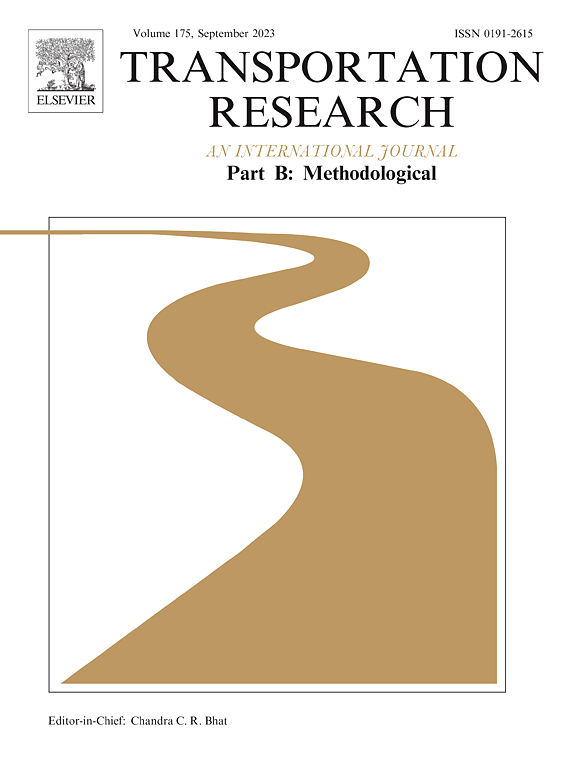在出行时间不确定的情况下,通过预留车道设计可靠的公交服务,保证准时到达
IF 6.3
1区 工程技术
Q1 ECONOMICS
引用次数: 0
摘要
公交专用道的设置是提高公交吸引力的关键策略,并且会受到各种不可预测事件的显著影响。本文提出并研究了在不确定出行时间下,共同考虑公交线道布置和公交线路的优化问题,以实现公交服务的可靠和准时到达为目标。我们首先将其表述为随机规划模型。通过利用先验数据,我们构建了一个基于柔性力矩信息的模糊集,以捕获不确定的链路行程时间,并将其纳入具有概率目标函数的分布鲁棒优化(DRO)模型。DRO模型最大限度地提高了公共汽车服务的可靠性,定义为在最坏情况下确保公共汽车准时到达每个站点,同时限制乘客等待时间的概率。在此基础上,引入了一个凸决策测度——违章风险概率,用于评价车辆在预定时间窗内未到达停车点的风险。然后将设计的模型重新表述为更易于处理的混合整数二阶锥规划,并在此基础上开发了一种专门用于求解大规模现实网络的两阶段数学算法(TSMA)。进行了大量的计算测试,以验证TSMA的有效性和效率。结果表明,DRO模型可以生成鲁棒的专用车道部署和总线路由方案,其最坏情况性能优于广泛采用的基于样本平均近似的方法、基于自适应蒙特卡罗模拟的元启发式算法和传统的基于Bonferroni校正的方法。此外,我们还将得到的解与确定性和鲁棒优化模型的解以及基于传统矩模糊集的DRO模型的解进行了比较。此外,我们还进行了数值实验,以得出有关预算,最大负面影响,预期到达时间窗口的紧密性和准时停止到达率的有意义的结论。本文章由计算机程序翻译,如有差异,请以英文原文为准。
Designing reliable bus services with on-time arrival via lane reservation under uncertain travel times
The deployment of dedicated bus lanes is a crucial strategy to improve the appeal of bus transit and is significantly affected by a variety of unpredictable events. This study proposes and investigates a novel optimization problem that jointly considers bus lane deployment and bus routing under uncertain travel times, with the objective of achieving reliable bus services with on-time arrivals. We first formulate it as a stochastic programming model. By leveraging prior data, we then construct a flexible moment information-based ambiguity set to capture uncertain link travel times and incorporate it into a distributionally robust optimization (DRO) model with a probabilistic objective function. The DRO model maximizes the reliability of bus services, defined as the probability of ensuring that a bus arrives on time at each stop in the worst-case scenario while simultaneously limiting passenger waiting times. Furthermore, we introduce a convex decision measure called Probability of Violation Risk to evaluate the risk of any stop not being arrived at within the predetermined expected time window. The designed model is then reformulated as a more tractable mixed-integer second-order cone program, upon which a two-stage matheuristic algorithm (TSMA) is developed specifically to solve large-scale realistic networks. Extensive computational tests are performed to verify the effectiveness and efficiency of the TSMA. The results demonstrate that the DRO model can generate robust dedicated lane deployment and bus routing schemes, with worst-case performance that surpasses those achieved using the widely adopted sample average approximation-based approach, an adapted Monte Carlo simulation-based metaheuristic algorithm, and the conventional Bonferroni correction-based method. Moreover, we compare the obtained solutions with those derived from deterministic and robust optimization models, as well as the DRO model based on the traditional moment ambiguity set. Additionally, we conduct numerical experiments to draw meaningful conclusions regarding the budget, maximum negative impact, tightness of expected arrival time windows, and on-time stop arrival rates.
求助全文
通过发布文献求助,成功后即可免费获取论文全文。
去求助
来源期刊
CiteScore
12.40
自引率
8.80%
发文量
143
审稿时长
14.1 weeks
期刊介绍:
Transportation Research: Part B publishes papers on all methodological aspects of the subject, particularly those that require mathematical analysis. The general theme of the journal is the development and solution of problems that are adequately motivated to deal with important aspects of the design and/or analysis of transportation systems. Areas covered include: traffic flow; design and analysis of transportation networks; control and scheduling; optimization; queuing theory; logistics; supply chains; development and application of statistical, econometric and mathematical models to address transportation problems; cost models; pricing and/or investment; traveler or shipper behavior; cost-benefit methodologies.

 求助内容:
求助内容: 应助结果提醒方式:
应助结果提醒方式:


